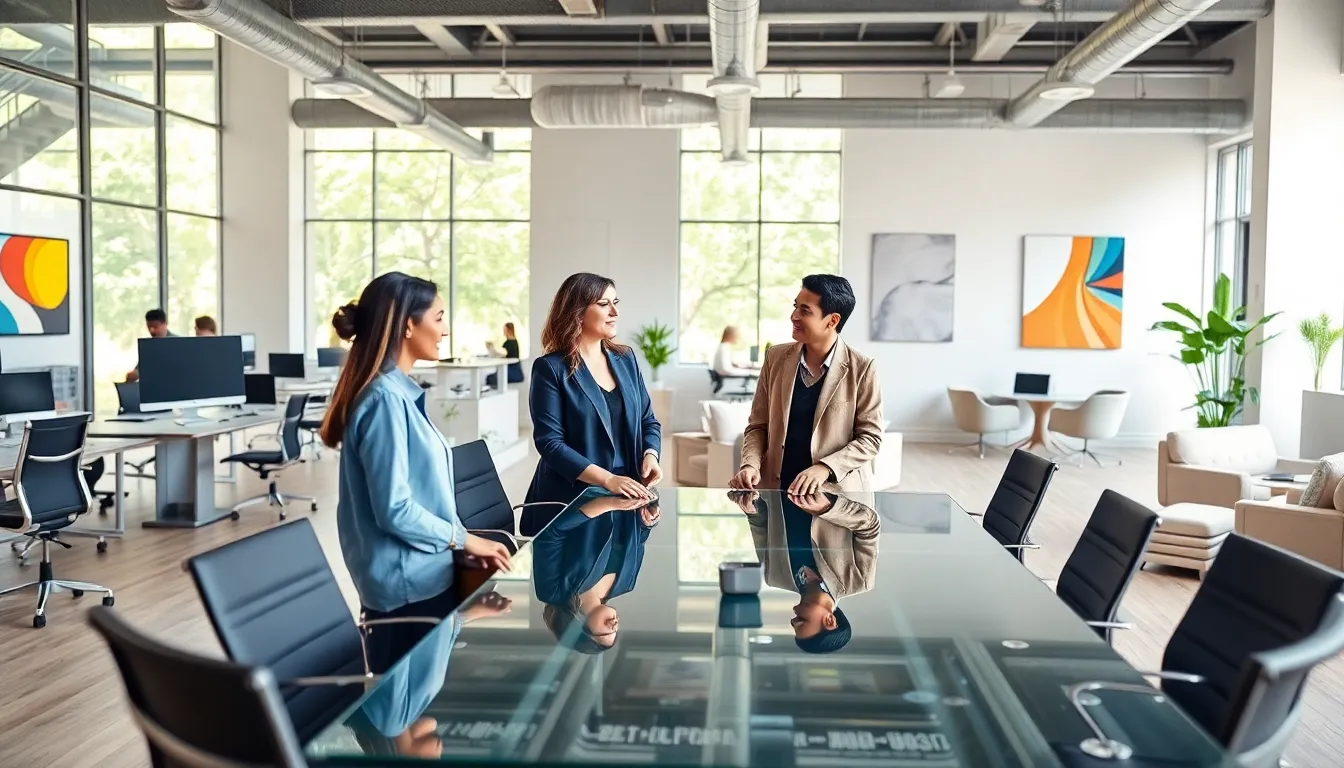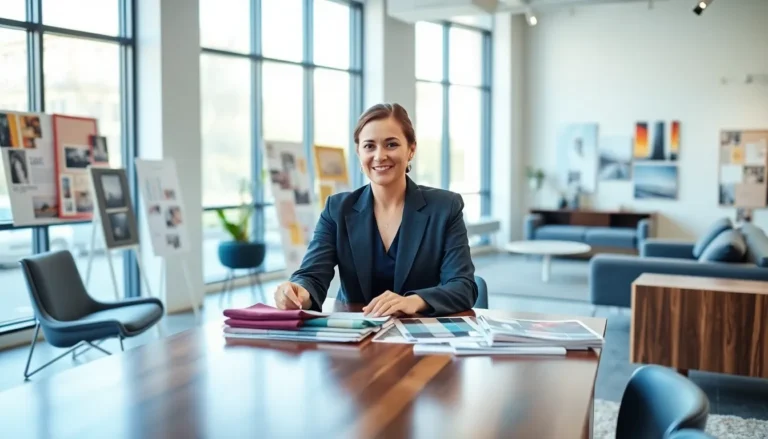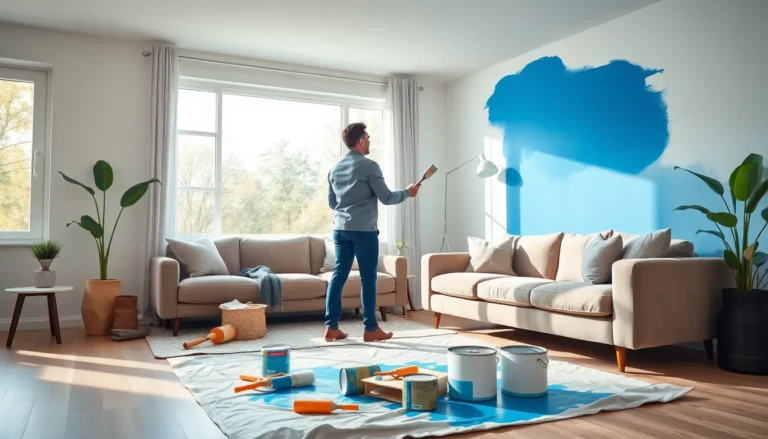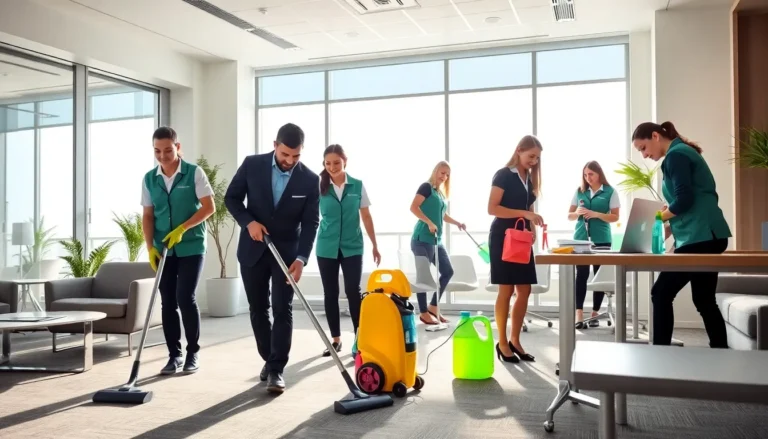Picture this: an office space that’s not just a place to work, but a haven for creativity and collaboration. If you think dull cubicles and flickering fluorescent lights are the way to go, think again. Corporate office interiors play a pivotal role in shaping the atmosphere and productivity of employees. And let’s face it, who wouldn’t want a workspace that inspires innovation while still letting you sip that all-important coffee? So buckle up as we explore the nuances of office interiors in the corporate world, reminding us all that design can enhance functionality and foster a vibrant work culture.
Table of Contents
ToggleThe Importance of Office Interiors in Corporate Environments

In today’s fast-paced corporate landscape, office interiors do more than just house furniture: they are an extension of a company’s brand ethos. A well-designed space communicates values, inspires employees, and impresses clients. Studies have shown that aesthetically pleasing environments can lead to increased productivity, reduced stress, and enhanced creativity. Imagine walking into a lobby adorned with vibrant artwork versus a drab, beige space, one instantly energizes, while the other might inspire a long day of yawns. Hence, investing in office interiors isn’t just a superficial concern: it’s a strategic business decision.
Creating a Positive Employee Experience
The corporate world is changing, with a growing emphasis on employee well-being. Interior design that prioritizes comfort, accessibility, and aesthetic appeal can significantly impact an employee’s experience. For instance, integrating ergonomic furniture in a workspace not only supports health but also encourages longer, more productive hours. Paying attention to details, like natural lighting, creates a warmer environment that can help reduce absenteeism and improve employee retention.
Reflecting Company Culture
Also, office interiors can serve as an expressive canvas for a company’s culture. Open layouts can foster collaboration, while quiet areas provide sanctuary for focused tasks. Each design choice sends a message about what a company values. Do they favor innovation or tradition? Openness or privacy? Your office design can articulate what words sometimes cannot.
Key Elements of Effective Office Interior Design
When diving into effective office interior design, several elements carry significant weight. First and foremost, functionality reigns supreme, the layout should align with the workflow of employees. Whether it’s collaborative spaces or quiet zones, understanding how teams interact to achieve their tasks is crucial.
Flexibility in Design
Flexibility is another pillar of effective design. Moving walls, modular furniture, and multipurpose spaces allow businesses to pivot as needs evolve. This adaptability can accommodate team expansions or dietary shifts without needing a complete overhaul. Why stick with yesterday’s needs when tomorrow is just around the corner?
Color Psychology
Color choices also play a pivotal role in interior design. Utilizing a color palette that resonates with the brand while promoting the right emotions is crucial. For example, blue can evoke trust and professionalism, while greens and yellows can boost creativity and energy. Selecting the perfect hues can turn sterile offices into inspiring spaces.
Technology Integration
Finally, tech integration cannot be overlooked. With many companies embracing remote work and digital collaborations, office interiors must adapt to these changes. Incorporating charging stations, soundproofing for calls, and connectivity tools enhance productivity and keep teams in sync. A well-designed office doesn’t merely house equipment: it facilitates the latest in workplace technology.
Trends in Corporate Office Interiors
The world of corporate office interiors is always evolving. Keeping abreast of the latest trends can help businesses stay competitive while also creating inviting workspaces.
Biophilic Design
One notable trend is biophilic design, incorporating natural elements into workspaces. This approach aims to deepen the connection between people and nature, and it’s been proven to reduce stress levels and enhance productivity. More companies are introducing indoor plants, water features, and even living walls. Who wouldn’t feel rejuvenated at work when surrounded by greenery?
Minimalism
On the opposite spectrum, minimalism continues to rise as a favorite. Clean lines, neutral colors, and uncluttered spaces help create a serene environment, allowing employees to focus better on their tasks. It’s all about stripping away distractions and embracing simplicity.
Wellness-Focused Design
Also, wellness-focused design has gained traction. Spaces designed for relaxation, such as meditation rooms or quiet pods, support mental health and encourage a work-life balance. Companies increasingly recognize that happy employees are productive employees. Consider how creating a zen-like atmosphere can boost workflow and creativity without sacrificing comfort.
Sustainable Practices in Office Design
Sustainability isn’t just a buzzword: it’s a responsibility. As more businesses become environmentally conscious, sustainable practices in office design are gaining momentum.
Eco-Friendly Materials
Utilizing eco-friendly materials can significantly reduce a company’s carbon footprint. From recycled carpets to sustainable wood furnishings, every choice contributes to a healthier planet. Companies that prioritize sustainability send a powerful message to both employees and clients, positioning themselves as socially responsible businesses.
Energy Efficiency
Incorporating energy-efficient systems is also paramount. Implementing smart lighting, energy-efficient HVAC systems, and sustainable energy sources like solar panels can help slash energy costs. Not only does this support the environment, but it also benefits the bottom line: green practices often result in significant savings over time.
Wellness and Sustainability
Finally, companies are merging wellness with sustainability. Features such as natural ventilation, daylight harvesting, and eco-friendly finishes enhance indoor air quality while creating healthier work settings. This harmonious balance improves employee well-being while allowing companies to contribute to a more sustainable future.
Case Studies: Successful Corporate Office Interiors
Looking at concrete examples can illuminate how effective and innovative office design can transform corporate environments.
Tech Giants
Consider the offices of tech giants like Google. Their workspaces are often designed with playful aesthetics, think vibrant colors, open spaces, and plenty of breakout areas. Such designs not only inspire creativity but also foster collaboration. Employees feel more at home and engaged, which often translates to increased productivity.
Financial Institutions
Alternatively, look at financial institutions like Barclays. Their recent office redesign focused on modern minimalism while emphasizing employee wellness. By creating quiet areas alongside collaborative spaces, they encourage both teamwork and solitary focus. Their success underscores the point that thoughtful office interiors can redefine a company’s image and improve work culture.
Startups
Even startups are getting creative with space. Companies like WeWork exemplify innovative office interiors that emphasize flexibility and community. Their design encourages networking and collaboration, making the office a fun place to be. Their success showcases that even smaller companies can create impactful work environments.






